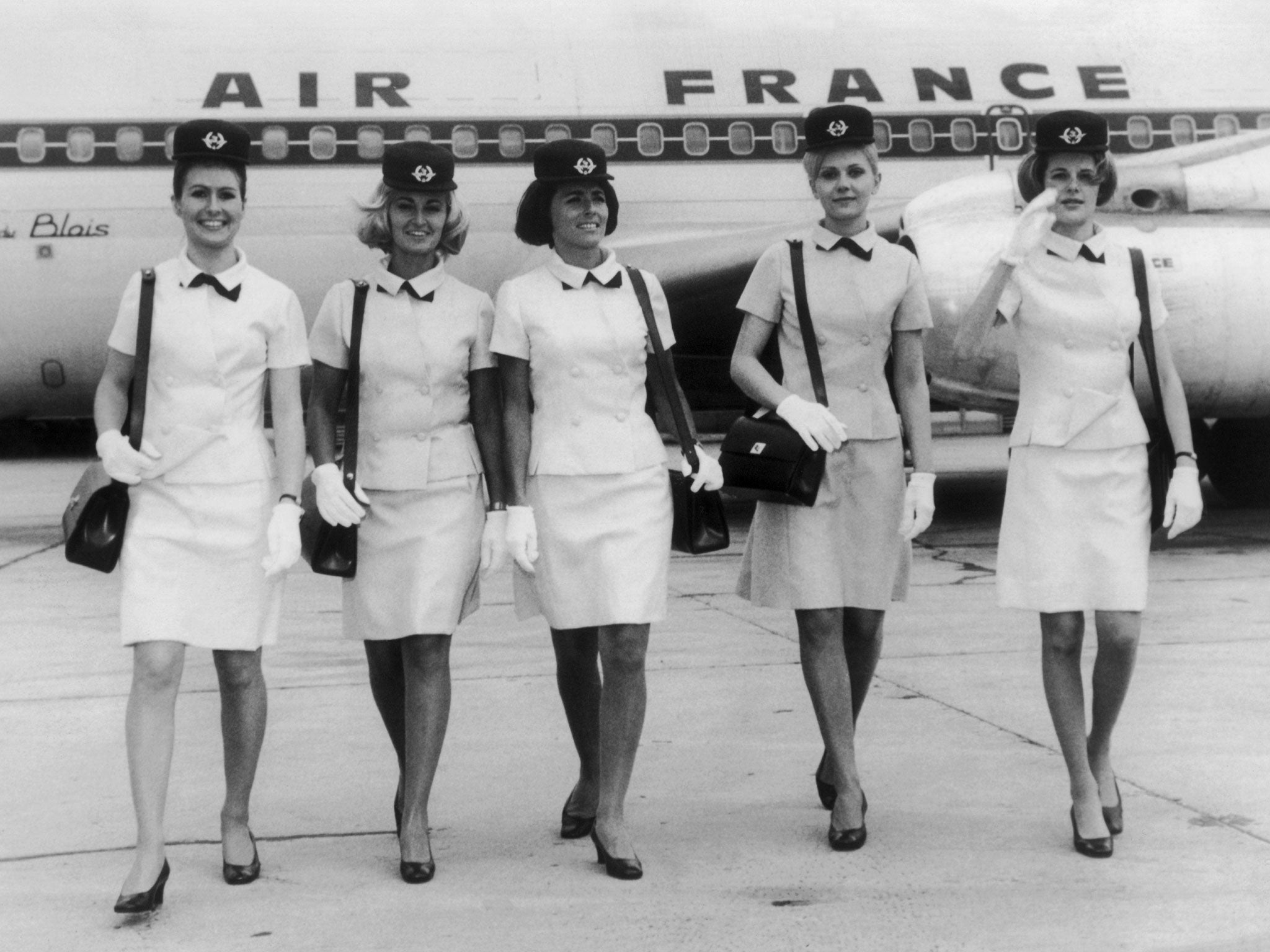From seafaring to psychedelia, air attendants' uniforms reflect our changing relationship with flight
Various designers being been drafted in to create uniforms, from Cristóbal Balenciaga to Zac Posen

Flight attendants' uniforms are drip-dry and crease-resistant, designed to withstand wear and tear, multiple washes and multiple flights. Not exactly a fashion fantasy. That hasn't prevented various designers being been drafted in to design uniforms, with varying degrees of success. From Cristóbal Balenciaga in 1968, who created a chic clutch of them for Air France, through to New York designer Zac Posen, whose Delta Airlines designs will be unveiled in 2018. In between, the names have been as varied as Gianfranco Ferré, Christian Lacroix and Vivienne Westwood, all of whom have wrestled with the conflicting demands of creativity and life at 40,000ft.
The first commercial air hostess uniforms in the 1930s resembled nurses' uniforms. They were designed to reassure customers embarking on voyages on the then still relatively new mode of transport. The message to passengers was simple: we will look after you, in any eventuality. Later, the uniforms borrowed motifs from the military and cruise liners – the phrase "steward" often being used, an echo of then-familiar seafaring parlance. By the 1950s, uniforms had borrowed dour cavalry twill, brass buttons and epaulettes, as well as the signature folded garrison or field service cap, glinting with a quasi-military airline insignia. For female flight attendants, those styles were fused with current, impractical fashions: from the late 1930s, fitted, nip-waisted suits, more feminine lines, and frequently softer colours began to come aboard.
The flight attendant became an "air hostess", with the dual implications of service and seduction, in the 1960s. It was at this time that airlines engaged fashion houses to design their uniforms. Out with the matronly peaked caps and below-the-knee suits, in with crazy fantasies dreamed up by designers. Balenciaga's semi-fitted Air France suits were a rare moment of sobriety and tied in with the pristine image of his couture house. Monsieur Balenciaga refused repeated offers to license a ready-to-wear line, replying that he would not prostitute his art. But a uniform, apparently, was OK – perhaps because of the underlying sense of function, rather than fashion. Maybe Balenciaga felt he was doing his duty.
If Air France were hoping for a publicity coup, it failed: Balenciaga steadfastly refused to be interviewed or engage with the press in any way throughout his career. He retired and closed his house the same year the uniforms were unveiled.
In quite a different vein were the peppy, print-packed designs cooked up by Emilio Pucci for Braniff International Airways. The US airline operated from 1928 until 1982 and launched a campaign titled "The end of the plain plane" in 1965. "No airline in the 1960s and '70s displayed more stylish pizzazz than Braniff International," wrote Melissa Keiser and David Romanowski in The Legacy of Flight. Braniff ditched a staid red, white, and blue livery in favour of a "jelly bean" fleet, in shades of tangerine, turquoise, baby blue and lemon, and offered innovative, loony-tunes touches – it even renamed its food, offering its flyers a complimentary "Branwich".
The uniforms were, arguably, the most startling feature of their end-of-plain philosophy. Pucci's fashion was renowned then as now for vibrant colours and graphic, psychedelic prints, much favoured by the newly aeronautically mobile "jet set" of the period. But a jet-setter in a Pucci dress may have been served by a hostess in a Pucci-print unitard, a tabbed pinafore dress, or wacky transparent PVC mackintosh coats, or bubble-shaped plastic helmets. Pucci dubbed these "Rain Domes" and designed them, ostensibly, with practicality in mind – they were to be worn between the terminal and the plane to prevent the rigid, hair-sprayed coiffures of the period from being disturbed by the elements.
The domes were dropped after about a month, as they frequently and rapidly developed fissures. Plus on-board storage was a nightmare. Pucci's Braniff uniforms were out-there, but they seemed cool to contemporary eyes. It was the Space Age Swinging Sixties after all, when couturiers were dressing everyday women as cosmonauts. The airline certainly seemed happy, too. Braniff commissioned Pucci to create uniform collections in 1966, 1968, 1972, and 1974.
Pucci got flight attendant attire, perhaps because he was a member of the jet-set himself. An independently wealthy Italian nobleman, his full title was the Marquis Emilio Pucci di Barsento. He designed his first clothes on a whim, while skiing, and accidentally kick-started the Italian ready-to-wear industry (numerous other Italian aristocrats designed clothes, including Princess Irene Galitzine, inventor of the palazzo pyjama).
A notorious playboy, Pucci also understood sexiness: one of his Braniff collections comprised an interchangeable wardrobe dubbed the "air strip" and involved the flight attendants taking off parts of the uniform as the flight progressed. All terribly old-fashioned and yet, you can't help but think Pucci's jersey knits and short dresses seem so much easier, so much more fashionable – and less uniform – than those cooked up more recently by Vivienne Westwood or Julien Macdonald (for Virgin Atlantic and British Airways, respectively).
What's the next step for flight attendant fashion? Earlier this month, the Adidas-affiliated brand Y-3, headed by avant-garde Japanese designer Yohji Yamamoto, announced it would be designing flight attendant uniforms for Virgin. No big deal, a fashion house and an aeronautical firm, working together again. Y-3's partnership, however, is slightly different: they're designing uniforms for the first commercial space craft. There is a flight-suit and boots designed for the "astronaut pilots" of the Virgin Galactic fleet, unveiled on 14 February at the world's first commercial spaceport, "Spaceport America", in New Mexico. It's the next step. I wonder if Pucci still has one of those helmets?
Subscribe to Independent Premium to bookmark this article
Want to bookmark your favourite articles and stories to read or reference later? Start your Independent Premium subscription today.

Join our commenting forum
Join thought-provoking conversations, follow other Independent readers and see their replies